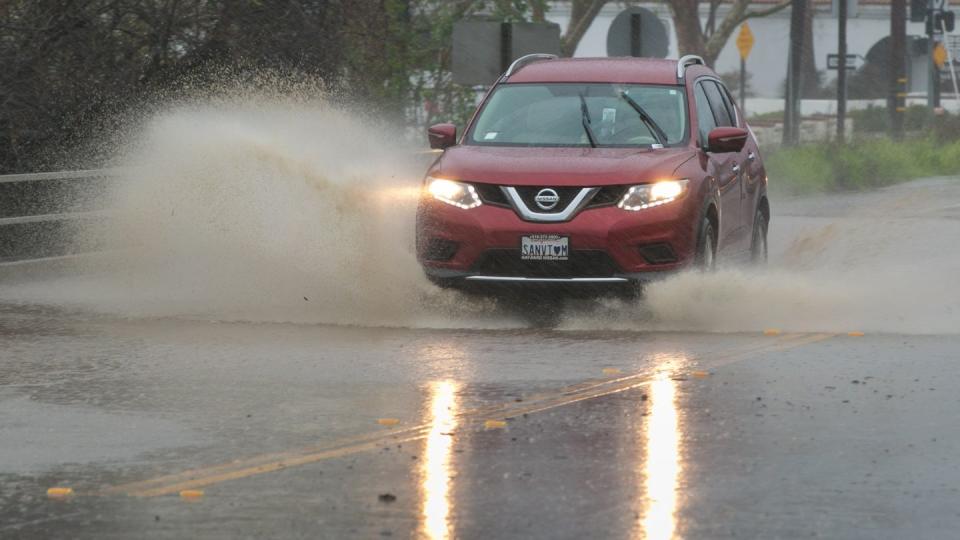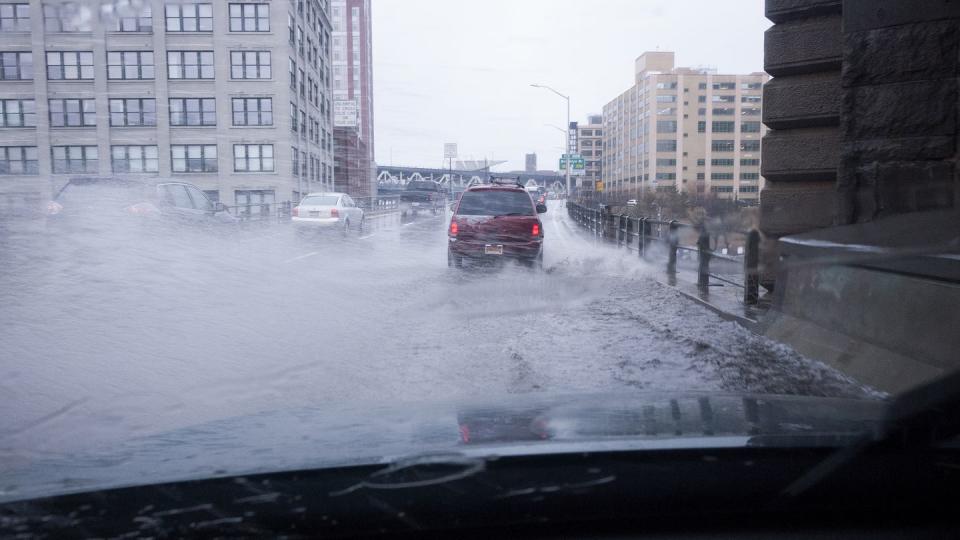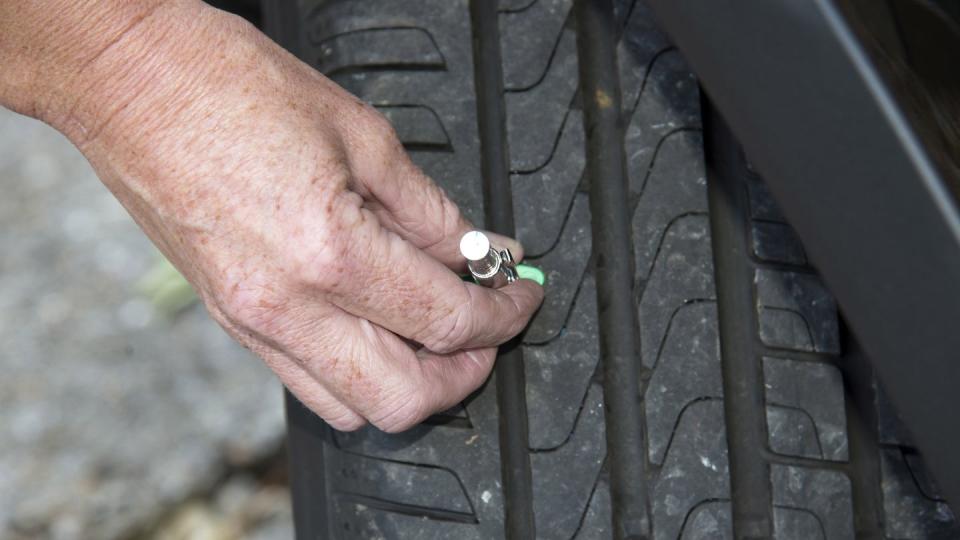Why Your Car Hydroplanes, and What to Do When It Happens

Hydroplaning, or aquaplaning, is a dangerous driving condition that occurs when water causes your car's tires to lose contact with the road surface. Whether it lasts for an instant or several seconds, hydroplaning is a jolting indication that you've lost all the available traction. In those moments, you are for all intents and purposes a passenger. It's scary. Here's how it happens, how to avoid it, and what to do when your car hydroplanes.
Think of the grooves in your tires as miniature aqueducts. They pump water away from the contact patch (where the rubber literally meets the road) at an amazing rate. Tiremaker Continental estimates that, at 50 mph, the average new tire can disperse nearly eight gallons of water per second. That's a lot to ask from a tiny piece of rubber operating on an area roughly the size of an adult man's outstretched hand. When a tire can't disperse water quickly enough, the contact patch starts to ride on the surface of the water, not the road—like water skis climbing onto the surface of a lake. That's hydroplaning. Have you ever driven through a large puddle that was much deeper than you anticipated, only to feel the steering wheel go light in your hands? That sudden loss of feedback is how you experience hydroplaning.

Many factors influence a tire's ability to resist hydroplaning. The depth of its tread is the most important of them. The deeper those grooves are, the more water they can pump away from the contact patch. According to tire seller Tire Rack, most new tires have tread depths less than 11/32 of an inch. As the tire wears, the tread depth decreases—and your potential to hydroplane increases. When your tread depth is only 2/32 of an inch—the legal minimum in most states—you must replace the tires because the danger of hydroplaning is greatly increased. It's easy to spot almost-bald tires: they're totally worn out when the tread grooves have faded almost entirely or if you notice the wear bars—strips of rubber crossing the width of the tire at 90 degrees to the grooves—are showing. (They stand proud of the valley floor of the circumferential grooves).
To be sure of the tread depth, take a penny and place it in each of the circumferential grooves with the top of Lincoln's head pointed toward the tire. If a groove doesn't overlap President Lincoln's head, your tires are at or below the legal minimum tread depth, increasing the likelihood of high-speed hydroplaning. If the groove overlaps the top of the Lincoln Memorial on the other side of the coin, your tire has at least 6/32 of an inch in tread depth—which is less than half worn. (You can also measure tread depth with a tread depth measuring gauge, as shown in the accompanying photo. They're available at auto parts stores and at some tire dealers.) Most tiremakers agree that wet performance and a tire's resistance to hydroplaning decreases dramatically when the tread depth is less than 4/32 of an inch. Moreover, tires tend to wear unevenly, so check all of the grooves. If only one groove is under the legal minimum, it's best to replace the tire. Rotating your tires regularly ensures even wear.
The design of a tire's tread, called the tread pattern, is not an accurate visual indicator of its ability to resist hydroplaning. That's why Car and Driver has run instrumented tests on various types of tires in identical controlled conditions and on the same car to reach an accurate comparison. Tire Rack also does independent tire testing. Wet performance isn't a one-size-fits-all measurement, either. Various rubber compounds deliver different amounts of traction depending on temperature and road surface. Even the same model of tire can perform differently in different sizes and on different vehicles.
The one constant that you can rely on is that a tire with adequate tread depth will always resist hydroplaning better than an identical tire with less than the minimum acceptable amount of tread depth.
How to Lessen the Chances of Hydroplaning
There are two things you can do to minimize the chance that your vehicle will hydroplane: maintain proper tire pressure and keep your vehicle's speed appropriate to conditions on wet roads. Underinflated tires can be more prone to hydroplaning, while badly overinflated tires can reduce grip in any situation. Driving fast increases the rate at which your tires must pump water, and if you exceed your tires' capability, unless you're a Formula 1 driver (whose tires can disperse up to 17 gallons per second at triple-digit speeds), you'll hydroplane. So just slow down, and despite your inner child telling you to hit every puddle, maybe try to avoid standing water when you safely can. This will reduce the possibility that you'll hydroplane, and lessen the severity of the event if you do
The condition of the road surface also influences hydroplaning. A modern, well-paved road is crowned and pitches toward the shoulders to assist in water evacuation. But how many of those are actually in your town? Ideally, you should be observing a road's gradient, undulations, and any dips where water can pool and flood the surface while driving in the rain. In other words, pay attention and look ahead. Using cruise control in rain is ill advised because you really need to be able to adjust your speed instantly. Also, remember that driving immediately after a rainstorm can be dangerous because oils within the asphalt can bead up on the road surface.

What to Do If Your Car Hydroplanes
Despite all that, at some point you may find your car is hydroplaning. Now what? If you're in the middle of a curve, you will feel the car take a big, sudden step towards the shoulder—a tangent from the curve. How can you recover once you start to hydroplane? Your car's stability control might detect the condition and may be able to correct a skid by applying individual brakes or even cutting power. But once you're skimming on the surface of water, as on ice, even the best electronics may not save you in time. If your tire condition and speed are both sensible, you'll generally be able to ride it out a hydroplaning event for the couple of seconds it takes to reach a section of the road without standing water. Until you regain traction, you really have no control. This is why panic is inappropriate behind the wheel; there's a good chance you can recover enough control to avoid or minimize the consequences even when things get scary.
Whether you're on a straight or curved road, you have a much higher chance of recovering from hydroplaning if you stay calm and make the right moves. At the first sign of hydroplaning, let off the throttle and attempt to steer in the direction you want to travel—doing so very gently. Abrupt, herky-jerky steering movements can induce a skid, as can slamming on the brakes. Gentle brake application while steering is fine on cars equipped with anti-lock brakes (ABS), which nearly all cars made in the past 20 years are equipped with. Be smooth and consistent with the brake pedal. If gentle steering inputs have no effect, don't keep adding steering angle. Wait for the front tires to bite; trust us, you'll feel it. All of this happens in seconds, so any panic maneuver could send you spinning.
As your speed decreases, your tires will quickly regain contact with the road. Keep slowing down, and remember what that felt like. Not good, right? But now you know what to do when your car hydroplanes: Look ahead. Reduce your speed. If you hit deep water, ease off the gas, and steer and brake gently. And make sure your tires have adequate tread depth and are properly inflated.
With enough preparation and common sense, you can prevent hydroplaning, or at least be ready to deal with it when it happens.
You Might Also Like

 Yahoo Autos
Yahoo Autos 